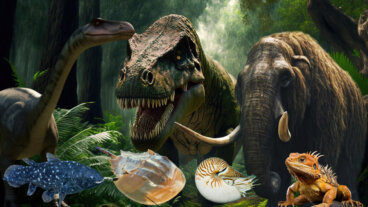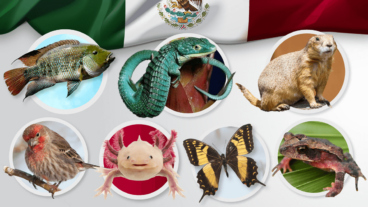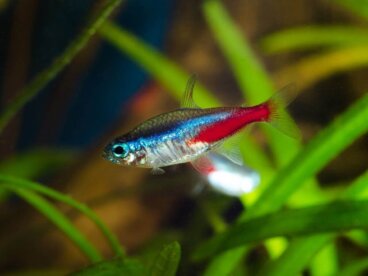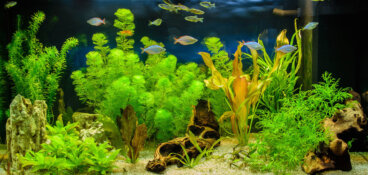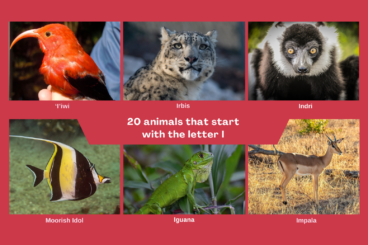The Abalone, a Very Peculiar Mollusk
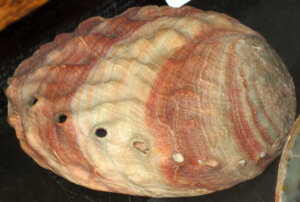

Written and verified by the biologist Cesar Paul Gonzalez Gonzalez
The abalone is one of the most appreciated mollusks by fishermen and traders, as it has several uses in many countries’ local gastronomy. In fact, due to its great demand, cultivation techniques have been developed that focus on reproducing the most popular specimens.
Contrary to what you may think, more than a hundred different species are called “abalone”. All of them belong to the genus Haliotis, a group of monotypic gastropods distributed in tropical waters around the world. Continue reading and discover more about the peculiar abalone.
What is the abalone like?
This mollusk is characterized by a long, flat, oval shell with a spiral-shaped tip. This protection is hard, irregular, and has a texture similar to that of a rock at the bottom of the ocean. However, there are some species that can show off bright and brilliant colors.
The shell has several grooves that follow the spiral pattern, in addition to some openings on the edges that have direct contact with the animal’s fleshy mass. As in snails, behind its protection, the abalone’s body is divided into a foot (the movement muscle), visceral mass (organs), and mantle (secreting the shell).
At first glance they look quite similar to a clam, with the big difference that they only have one shell and their fleshy mass is exposed on the other side. This doesn’t pose a risk to the abalone, as they stick to the ground with their foot and their shell becomes more visible. In this way, it’s unlikely that a predator can eat it.
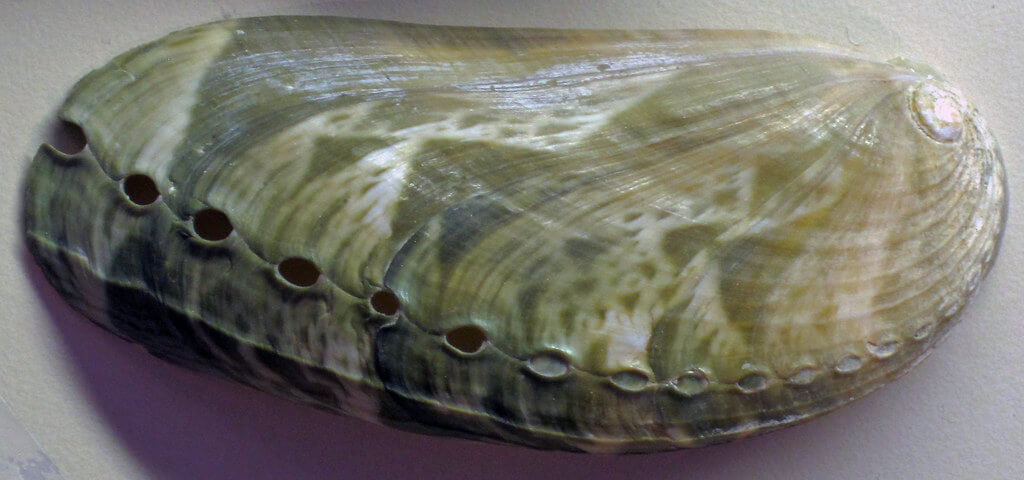
Abalone species
Abalone have different characteristics, size, coloration, and distribution, depending on the species. Among the most important and well-known in the world are the following:
- Red abalone (Haliotis rufescens): This is the largest with a maximum size of 30 centimeters (12 inches) in diameter. It has a brick-red shell color and is naturally distributed throughout the Pacific Ocean.
- Yellow abalone (Haliotis corrugata): This measures 18 centimeters (7 inches) in diameter on average and has a rather wrinkled shell with opaque colors (green, brown and brown). It’s distributed from California to the south of Bahia Tortuga in Baja California.
- Blue abalone or green abalone (Haliotis fulgens): it receives its name because the inside of its shell has bright green and blue colorations. It reaches sizes of almost 25 centimeters (10 inches) in diameter. It extends from southern California to Magdalena Bay in Baja California.
- Giant abalone (Haliotis gigantea): It’s one of the longest specimens of all, which gives it the appearance of being large. It reaches a size of almost 20 centimeters (8 inches) in diameter and has a shell with red or brown coloration. It’s found in the waters near Japan and Korea.
- Korean abalone (Haliotis discus): Recognized for its iridescent shell colors. They reach a size of 18 centimeters (7 inches) in diameter. It can be found from Siberia to China, but its population is more concentrated on the Asian coasts. In fact, this is the reason why it’s such a popular food in the region.
Abalone behavior and feeding
Abalone spend most of the day motionless on the seabed attached to a hard surface. However, as soon as night falls, they tend to move with slow movements in order to search for their food. In this way, they avoid most predators.
These mollusks are herbivores, so they feed on the different micro and macro algae that grow in the oceans. While it’s true that each species may have a preference for a specific type of algae (green, brown or red), they don’t have any dietary restrictions.
Why are they so important to humans?
Of the more than 100 species of abalone that exist in the world, only about 15 are used for human consumption. Although they’re few, the demand for this type of organism is quite high because it provides different nutrients such as proteins, carotenes, calcium, iron, potassium, zinc, and iodine. In addition, the taste of these mollusks is sweet and delicate, with a firm texture similar to that of an octopus.
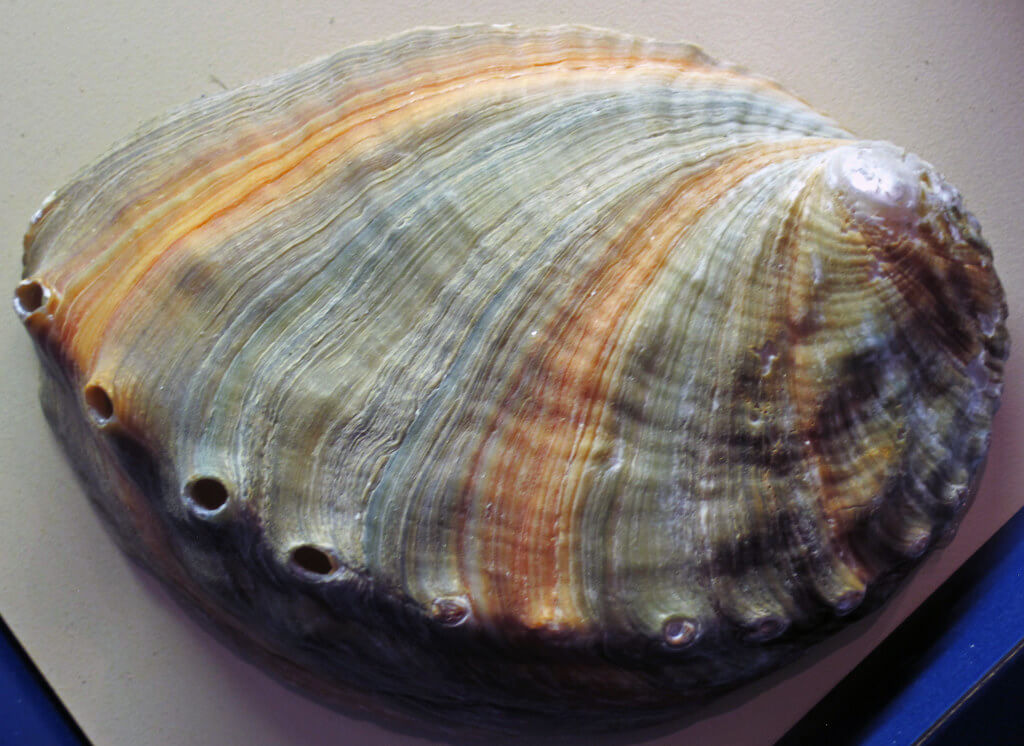
Despite its great nutritional value and taste, this product is quite expensive and unaffordable for most people. This is due to the fact that it takes between 4 and 5 years to reach the average commercial size. It also requires precise and well-controlled hygienic conditions. Otherwise, the flavor could be affected, as it depends a lot on the quality of the crop.
As if that weren’t enough, some cultures associate its consumption with certain therapeutic and aphrodisiac effects that go beyond its nutritional benefits. Consequently, its popularity has increased and some countries have encouraged the development of breeding plants to sell it.
As you can see, abalone is a unique mollusk of great economic and cultural value. In fact, some of its species are considered the most expensive mollusks in the world, as their cost exceeds the price of other similar animals (up to 2000 euros per kilo). Of course, it’s still little known in some countries, but it’s sure to soon become a prized delicacy, valued for its nutritional benefits.
The abalone is one of the most appreciated mollusks by fishermen and traders, as it has several uses in many countries’ local gastronomy. In fact, due to its great demand, cultivation techniques have been developed that focus on reproducing the most popular specimens.
Contrary to what you may think, more than a hundred different species are called “abalone”. All of them belong to the genus Haliotis, a group of monotypic gastropods distributed in tropical waters around the world. Continue reading and discover more about the peculiar abalone.
What is the abalone like?
This mollusk is characterized by a long, flat, oval shell with a spiral-shaped tip. This protection is hard, irregular, and has a texture similar to that of a rock at the bottom of the ocean. However, there are some species that can show off bright and brilliant colors.
The shell has several grooves that follow the spiral pattern, in addition to some openings on the edges that have direct contact with the animal’s fleshy mass. As in snails, behind its protection, the abalone’s body is divided into a foot (the movement muscle), visceral mass (organs), and mantle (secreting the shell).
At first glance they look quite similar to a clam, with the big difference that they only have one shell and their fleshy mass is exposed on the other side. This doesn’t pose a risk to the abalone, as they stick to the ground with their foot and their shell becomes more visible. In this way, it’s unlikely that a predator can eat it.

Abalone species
Abalone have different characteristics, size, coloration, and distribution, depending on the species. Among the most important and well-known in the world are the following:
- Red abalone (Haliotis rufescens): This is the largest with a maximum size of 30 centimeters (12 inches) in diameter. It has a brick-red shell color and is naturally distributed throughout the Pacific Ocean.
- Yellow abalone (Haliotis corrugata): This measures 18 centimeters (7 inches) in diameter on average and has a rather wrinkled shell with opaque colors (green, brown and brown). It’s distributed from California to the south of Bahia Tortuga in Baja California.
- Blue abalone or green abalone (Haliotis fulgens): it receives its name because the inside of its shell has bright green and blue colorations. It reaches sizes of almost 25 centimeters (10 inches) in diameter. It extends from southern California to Magdalena Bay in Baja California.
- Giant abalone (Haliotis gigantea): It’s one of the longest specimens of all, which gives it the appearance of being large. It reaches a size of almost 20 centimeters (8 inches) in diameter and has a shell with red or brown coloration. It’s found in the waters near Japan and Korea.
- Korean abalone (Haliotis discus): Recognized for its iridescent shell colors. They reach a size of 18 centimeters (7 inches) in diameter. It can be found from Siberia to China, but its population is more concentrated on the Asian coasts. In fact, this is the reason why it’s such a popular food in the region.
Abalone behavior and feeding
Abalone spend most of the day motionless on the seabed attached to a hard surface. However, as soon as night falls, they tend to move with slow movements in order to search for their food. In this way, they avoid most predators.
These mollusks are herbivores, so they feed on the different micro and macro algae that grow in the oceans. While it’s true that each species may have a preference for a specific type of algae (green, brown or red), they don’t have any dietary restrictions.
Why are they so important to humans?
Of the more than 100 species of abalone that exist in the world, only about 15 are used for human consumption. Although they’re few, the demand for this type of organism is quite high because it provides different nutrients such as proteins, carotenes, calcium, iron, potassium, zinc, and iodine. In addition, the taste of these mollusks is sweet and delicate, with a firm texture similar to that of an octopus.

Despite its great nutritional value and taste, this product is quite expensive and unaffordable for most people. This is due to the fact that it takes between 4 and 5 years to reach the average commercial size. It also requires precise and well-controlled hygienic conditions. Otherwise, the flavor could be affected, as it depends a lot on the quality of the crop.
As if that weren’t enough, some cultures associate its consumption with certain therapeutic and aphrodisiac effects that go beyond its nutritional benefits. Consequently, its popularity has increased and some countries have encouraged the development of breeding plants to sell it.
As you can see, abalone is a unique mollusk of great economic and cultural value. In fact, some of its species are considered the most expensive mollusks in the world, as their cost exceeds the price of other similar animals (up to 2000 euros per kilo). Of course, it’s still little known in some countries, but it’s sure to soon become a prized delicacy, valued for its nutritional benefits.
All cited sources were thoroughly reviewed by our team to ensure their quality, reliability, currency, and validity. The bibliography of this article was considered reliable and of academic or scientific accuracy.
- Suleria, H. A. R., Masci, P. P., Gobe, G. C., & Osborne, S. A. (2017). Therapeutic potential of abalone and status of bioactive molecules: A comprehensive review. Critical reviews in food science and nutrition, 57(8), 1742-1748.
- Revollo Fernández, D. A., & Sáenz-Arroyo, A. (2012). The historical ecology of abalone (Haliotis Corrugata and Fulgens) in the Mexican Pacific. México y la Cuenca del Pacífico, 1(2), 89-111.
- Tutschulte, T. C., & Connell, J. H. (1988). Feeding behavior and algal food of three species of abalones(Haliotis) in southern California. Marine ecology progress series. Oldendorf, 49(1), 57-64.
- Viana, M. T. (1998). Nutrición de Abulón. Avances en Nutrición Acuicola.
- Junta Nacional Asesora de Cultivos Marinos. (2009). Informe Global del Proyecto: “Cultivo y gestión de oreja de mar Haliotis tuberculata spp”. Recuperado el 9 de noviembre de 2022, disponible en: https://www.mapa.gob.es/app/jacumar/planes_nacionales/Documentos/88_IF_OREJA.pdf
- Aragón, C. (2013). Identificación de especies de abulón (Haliotis spp.) con marcadores moleculares. (Tesis de grado, Instituto Politécnico Nacional).
This text is provided for informational purposes only and does not replace consultation with a professional. If in doubt, consult your specialist.


